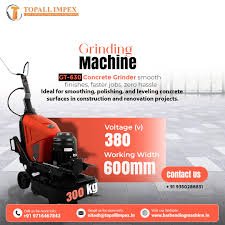
Concrete grinding is a vital process in the construction, renovation, and flooring industries. From leveling uneven surfaces to preparing floors for polishing, the concrete grinder has become an indispensable tool. However, traditional grinding methods can generate excessive dust and waste, creating environmental, health, and operational challenges.
Today, with growing awareness about sustainability, professionals are shifting toward eco-friendly concrete grinding methods that focus on dust control and waste reduction. By partnering with reputable Concrete Grinder Manufacturers and Concrete Grinder Suppliers, businesses can adopt greener practices without compromising performance.
In this article, we’ll explore the importance of dust control, strategies for minimizing waste, and the role of eco-friendly equipment in sustainable construction.
1. The Environmental Impact of Concrete Grinding
Concrete grinding involves the use of diamond abrasive tools to smooth or level concrete surfaces. While effective, the process generates two major byproducts:
-
Concrete Dust (Silica Dust) – A fine, airborne particulate that can be harmful if inhaled. Prolonged exposure to crystalline silica can lead to respiratory diseases like silicosis and chronic obstructive pulmonary disease (COPD).
-
Grinding Slurry & Waste – This includes leftover debris, broken diamond segments, and water-based slurry from wet grinding. Improper disposal can contribute to environmental pollution.
By implementing eco-friendly techniques, contractors can significantly reduce the negative impact of grinding activities.
2. Importance of Dust Control in Concrete Grinding
Dust control is more than just a safety measure — it’s a legal requirement in many countries. The Occupational Safety and Health Administration (OSHA), for example, mandates strict silica dust exposure limits.
Why dust control matters:
-
Worker Safety: Protects operators from harmful silica dust inhalation.
-
Job Site Cleanliness: Keeps surrounding areas free from debris, making post-work cleanup easier.
-
Compliance: Meets safety regulations and avoids costly fines.
-
Environmental Protection: Prevents dust from contaminating air and nearby water sources.
Key dust control methods:
-
Wet Grinding Technique – Adding water during grinding suppresses airborne particles, turning dust into a slurry that’s easier to manage.
-
Vacuum Extraction Systems – High-efficiency dust extractors capture fine dust directly from the grinder, preventing it from spreading.
-
Enclosed Grinding Machines – Some Concrete Grinder Manufacturers now produce models with built-in dust shrouds to enhance containment.
3. Waste Reduction in Concrete Grinding
Apart from dust, waste in the form of concrete debris and used abrasives can add to a project’s environmental footprint. Minimizing waste not only benefits the planet but also saves on disposal costs.
Practical waste reduction strategies:
-
Optimizing Grinding Techniques: Skilled operators remove only the necessary surface layer, avoiding excessive material loss.
-
Recycling Concrete Waste: Ground concrete can be recycled into aggregate for new construction projects, reducing demand for virgin materials.
-
Reusable Diamond Tooling: Choosing high-quality, long-lasting grinding discs from trusted Concrete Grinder Suppliers means fewer replacements and less waste.
-
Efficient Equipment Maintenance: Well-maintained grinders operate efficiently, reducing unnecessary wear and waste generation.
4. Eco-Friendly Concrete Grinder Innovations
Modern Concrete Grinder Manufacturers are focusing on eco-conscious product design. Here are some innovations shaping sustainable grinding:
-
Low-Dust and Dustless Grinders – Equipped with advanced vacuum attachments and dust shrouds to ensure maximum particle capture.
-
Energy-Efficient Motors – Use less electricity while delivering the same or higher grinding performance.
-
Recyclable Machine Components – Designed with replaceable, recyclable parts to extend machine life and reduce landfill waste.
-
Wet/Dry Hybrid Models – Allow contractors to switch between wet and dry grinding based on the environment and project needs.
5. Choosing the Right Concrete Grinder for Sustainable Operations
Selecting the right grinder is a crucial step in implementing eco-friendly practices. When consulting with Concrete Grinder Suppliers, consider:
-
Dust Collection Capability: Look for grinders with integrated dust management systems.
-
Compatibility with Eco-Friendly Accessories: Ensure the grinder supports wet grinding kits and high-efficiency vacuum systems.
-
Durability and Longevity: Opt for machines from reputable Concrete Grinder Manufacturers that are built to last, reducing waste from frequent replacements.
-
Power Efficiency: Choose energy-efficient models that reduce overall operational costs and carbon footprint.
6. Best Practices for Eco-Friendly Concrete Grinding
To maximize environmental benefits, follow these best practices on every project:
-
Pre-Plan the Work Area: Seal off surrounding spaces to contain dust and protect non-work zones.
-
Use High-Quality Equipment: Partner with certified Concrete Grinder Suppliers to access professional-grade tools.
-
Train Operators on Green Techniques: Proper handling reduces waste and improves grinding efficiency.
-
Implement Dust Control Systems: Always use water suppression or industrial vacuums.
-
Dispose of Slurry Responsibly: Treat slurry to separate solids and water before disposal or reuse.
-
Recycle Wherever Possible: Find recycling centers that accept concrete waste for repurposing.
7. The Role of Suppliers and Manufacturers in Sustainability
Both Concrete Grinder Manufacturers and Concrete Grinder Suppliers play a vital role in promoting eco-friendly grinding. They provide:
-
Access to Latest Technology: Ensuring contractors have the most advanced dust control and waste reduction tools.
-
Operator Training & Support: Educating customers on safe, sustainable grinding practices.
-
Spare Parts Availability: Encouraging repair over replacement to minimize waste.
-
Eco-Certified Products: Offering equipment that meets environmental safety standards.
By collaborating with reliable suppliers, contractors can not only meet project requirements but also align with global sustainability goals.
8. Final Thoughts
Eco-friendly concrete grinding is no longer an optional practice — it’s becoming an industry standard. By integrating dust control and waste reduction measures, contractors can protect worker health, comply with regulations, and contribute to environmental preservation.
Investing in high-quality equipment from trusted Concrete Grinder Manufacturers and working closely with professional Concrete Grinder Suppliers ensures that sustainability doesn’t come at the cost of performance.
In the long run, green grinding isn’t just better for the planet — it’s better for business. Reduced waste, lower cleanup costs, and improved job site safety create a win-win scenario for everyone involved.

